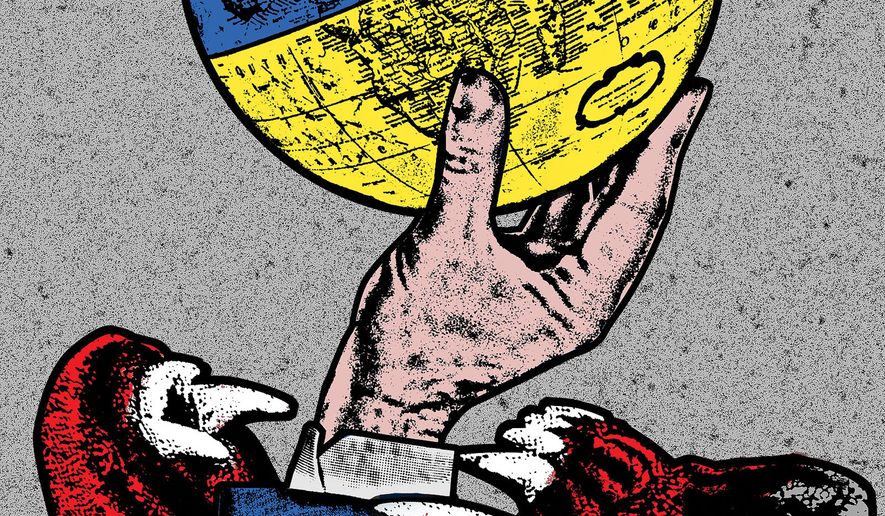OPINION:
Dear Mr. President,
First, kudos to you for going to Kyiv. Not many sitting American presidents have visited active war zones. I’m told that Vladimir Putin was informed you’d be there. Though he’d have been crazy to take a shot, you took a risk.
Second, the speech you gave in Warsaw was powerful. One might even call it Reaganesque. (I hope that doesn’t trigger you!) You made a pledge: “Our support for Ukraine will not waver, NATO will not be divided, and we will not tire.”
An important point: If you will the ends, you must will the means. Or to put it in the vernacular: If you’re going to talk the talk, you’ve got to walk the walk.
For the past year, you’ve been providing the Ukrainians enough weapons to prevent them from losing but not enough to give them a real chance to drive out the invaders. Why not ask such military experts as retired Army Gen. Jack Keane what’s necessary to get the job done as fast as possible? (More on how this war could end below.)
One positive revelation emerging from this conflict: The Ukrainians have demonstrated that weapons made in America by Americans are far superior to what Mr. Putin produces. But what’s also been revealed is that the American defense-industrial base is woefully inadequate to the challenges our country now faces.
In the late 1930s, despite the Great Depression, President Franklin D. Roosevelt turned America into “the arsenal of democracy.” We remained a daunting military power through the Cold War. After the collapse of the Berlin Wall, however, we took a supersize peace dividend.
Today, not only can’t our factories produce the weapons and ammunition needed by friends under attack (e.g., Ukraine) or threatened (e.g., Taiwan), they are also unable to provide the weapons we may require over the years ahead as quickly as necessary and in the quantities necessary. It’s your job to begin fixing that, and expeditiously.
Speaking of Taiwan, you’ve said on several occasions that you would defend it — and not just with materiel, as you’ve been doing for Ukraine. Your advisers have walked those pledges back to the long-standing U.S. policy of “strategic ambiguity.” But the analysts I trust say we can’t, at this moment, be confident that we would win a conflict with China.
If Xi Jinping, China’s expansionist ruler, also sees it that way, conflict becomes more likely. “Peace through strength” means deterring adversaries. We failed to deter Mr. Putin with threats of sanctions and the disapproval of the “international community.” Shouldn’t we learn from that failure?
Another problem: The moral argument for supporting Ukraine is obvious to most people but you still haven’t made clear why its defense is a vital American national interest. It’s simple: The war in Ukraine is not just about Ukraine.
The rulers of neoimperialist Russia, Communist China and Islamist Iran share a goal: the diminishment — if not death — of the United States.
They are determined to replace the post-World War II American-led international order with a new system that makes the world safe for autocracy, one in which they make the rules with the United States dismissed as decadent and declining, a has-been superpower, squandering its energies over bathrooms and pronouns.
Mr. President, have you read “The Long Game: China’s Grand Strategy to Displace American Order”? It’s written by Rush Doshi. He’s the China director on your National Security Council.
OK, let’s talk about how this war could end. Former President Donald Trump recently told radio host Hugh Hewitt: “The United States should negotiate peace between these two countries.” Our allies in Berlin, Paris and London want to offer Kyiv stronger ties with NATO – short of full membership — to encourage Ukrainian President Volodymyr Zelenskyy to start peace talks with Mr. Putin.
What this approach conspicuously ignores: Mr. Putin’s goal is the restoration of the Russian empire. So long as he believes he can win, he will not negotiate seriously.
He will merely dictate conditions for Ukraine’s surrender — and by extension, America’s — just as the Taliban did during the misguided negotiations Mr. Trump initiated and which you — forgive my candor — took to a disgraceful conclusion, one that undoubtedly influenced Mr. Putin’s thinking and planning.
The only way Czar Vladimir will settle for an outcome that falls short of victory is if he’s convinced that he’s losing on the battleground and can cut a better deal at the bargaining table.
He has nuclear weapons, so you’ve taken pains not to “provoke” him. That’s understandable — to a point. Because if the U.S. is perceived as succumbing to his nuclear blackmail, Mr. Xi will follow suit, as will North Korean dictator Kim Jong Un, who also has nukes, thanks to decades of failed American diplomacy and policy.
And you must know that the deal you keep offering Iranian Supreme Leader Ali Khamenei — billions of dollars in exchange for an empty promise to slow-roll his nuclear weapons program — is a charade that would lead Tehran to use nuclear blackmail to make America submit, too.
So, what does all this imply? That you must take actions you’ve never wanted to take, most significantly to rebuild America’s military capabilities as rapidly as possible. Nothing less will do if the goal is to reestablish deterrence. Will that require putting aside or even cutting your other priorities? Yep, afraid so.
Mr. President, the world we bequeath to our children and grandchildren will either be led by America or dominated by tyrants who despise America. There is no alternative. Ukraine is one battle in a wider war already underway.
That’s the challenge you face. Some people don’t think you’re up to it. I’ve written this letter because I dearly want you to prove them wrong.
Your friend,
Cliff
• Clifford D. May is founder and president of the Foundation for Defense of Democracies (FDD) and a columnist for The Washington Times.




Please read our comment policy before commenting.